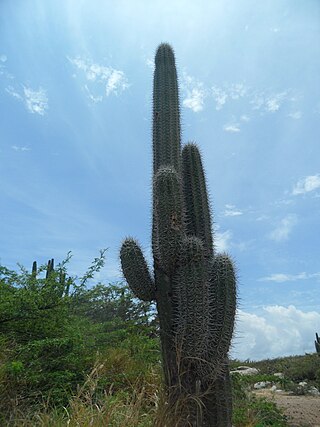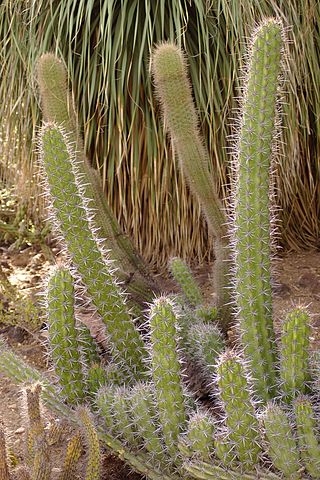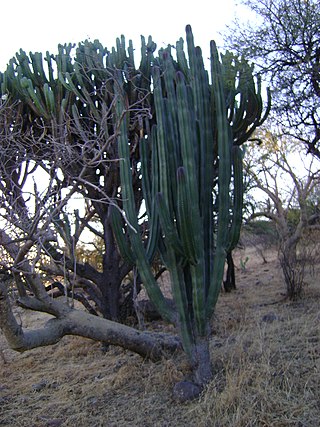
Stenocereus is a genus of columnar or tree-like cacti from the Baja California Peninsula and other parts of Mexico, Arizona in the United States, Colombia, Costa Rica, Guatemala, Venezuela and the West Indies. The genus has been enlarged by the addition of species from several other genera. A close relative is the peculiar chinoa or chende cactus, Polaskia chende.

Polaskia is a genus of tree-like cacti reaching 4–5 m high, comprising 2 species. Both present primitive characteristics, but Polaskia chichipe is nearer to Myrtillocactus while Polaskia chende is nearer to Stenocereus. The genus is found in the Mexican states of Puebla and Oaxaca.

Isolatocereus is a monotypic genus of flowering plant in the family Cactaceae. The only species is Isolatocereus dumortieri that is found in Mexico.

Stenocereus alamosensis is a species of cactus native to Mexico.

Stenocereus griseus, also known as the Mexican organ pipe, dagger cactus, pitaya, and pitayo de mayo, is a species of cactus.

Stenocereus queretaroensis is a species of cactus from Mexico, including the state of Querétaro. It is cultivated for its fruit.

Cochemiea conoidea, common name Texas cone cactus or Chihuahuan beehive, is a species of cactus native to southern United States to central Mexico.

Stenocereus pruinosus is a species of cactus. It is endemic to Mexico and occurs in the states of Veracruz, Puebla, and Oaxaca.

Stenocereus gummosus is a flowering plant in the family Cactaceae that is found in Baja California, Mexico at elevations of 9 to 134 meters

Stenocereus montanus, known as sahuira, is a species of columnar cactus in the family Cactaceae.

Stenocereus heptagonus is a species of cactus.

Stenocereus martinezii is a species of flowering plant in the family Cactaceae, native to Sinaloa in Mexico. A candelabriform cactus typically 5 to 7 m tall, it is easy to propagate from cuttings, so local people use it to build live fences.

Pachycereus weberi is a columnar cactus plant native to Mexico.

Stenocereus treleasei, commonly known as tunillo, is a species of flowering plant in the family Cactaceae, native to Oaxaca in Mexico.
Stenocereus fricii is a species of cactus in the genus Stenocereus, endemic to Mexico.
Stenocereus chacalapensis is a species of cactus in the genus Stenocereus, endemic to Mexico.
Stenocereus chrysocarpus is a species of cactus in the genus Stenocereus, endemic to Mexico.
Stenocereus humilis is a species of cactus in the genus Stenocereus, endemic to Mexico.

Stenocereus quevedonis is a species of cactus in the genus Stenocereus, endemic to Mexico.

Stenocereus standleyi is a species of cactus in the genus Stenocereus, endemic to Mexico.




















